Here is how I recommended you do the sign "100."
The "C" hand can be thought of as being similar to the Roman numeral "C" which equals 100.
You can use the "C method" for all of the 100's signs from 100 to 900 if you want.
100:
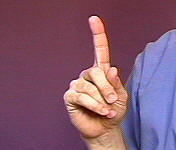
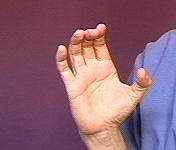
Note: Don't get hung up on making perfect "C" handshapes. I'm not doing the "flying pinkie" on purpose in some of the following signs. It is just a straggler. But I'm not concerned about it either. It's a non-issue. When you practice, go ahead and use a "good looking" C handshape, but realize that later on as you become fluent the shape will "morph" a bit.
To sign numbers 101 through 109 I just show 1-0-1, 1-0-2, 1-0-3...1-0-9. Meaning, I show the individual number "one," quickly followed by a "zero," and another "one" to show the number 101.
Some people sign: 1C1 to mean 101. Or they use a modified
"index-finger-C" (see below) followed by a 1.
I prefer the "zero" method.
The rest of the "hundred" series (111, through 199) you just show the number 100 (1-C) followed by the second number. You'd sign 111 by showing a "one" then a "C" then the number eleven. Use that system from 111 through 199.
Here is how I recommended you do the sign "100."
The "C" hand can be thought of as being similar to the Roman numeral "C" which
equals 100.
You can use the "C method" for all of the 100's signs from
100 to 900 if you want.
100:


Note: You might see the number 100 done as, "1X."
I do NOT recommend the 1X version for students.
Why?
Several of my close friends and associates consider "1X" to be "wrong." They
are very adamant (strong willed) about it.
On the other hand, some of my other friends don't mind the "1X" version and
even prefer it.
But since some people argue against 1X and no one argues against 1C
-- I suggest you stick with the 1C version for "100."
Not recommended: "1X"
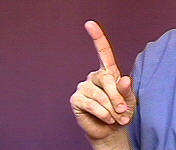
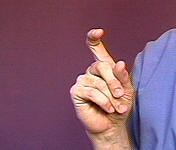
The numbers, 200, 300, 400, and 500 can use EITHER the bent fingers method
or the "C" handshape method of showing the concept of "hundred." Note:
600 through 900 use the "C" version only, but realistically the handshape
ends up looking somewhat like a "claw" (a loose "C.") I think the
point is that on 600 - 900 you have to change the first handshape into
either a "C" or a "loose C" -- you can't just bend the fingers on those. )
200:
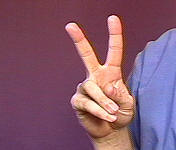

300
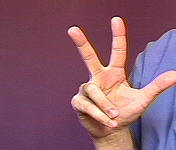

400:
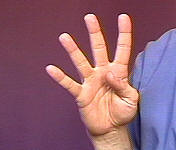
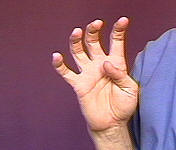
500:
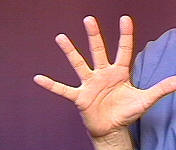
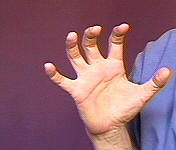
600:

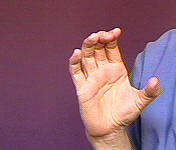
700:
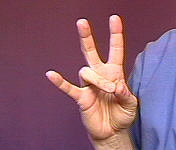
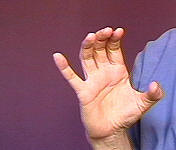
Note: Don't get hung up on making perfect "C" handshapes. I'm not doing the
"flying pinkie" on purpose here. It is just a straggler. But I'm
not concerned about it either. When you practice, go ahead and use a "good
looking" C handshape, but realize that later on as you become fluent the shape
will "morph" a bit.
800:
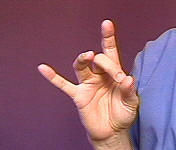
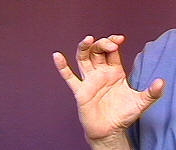
900:
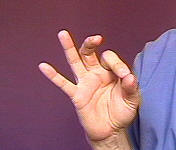
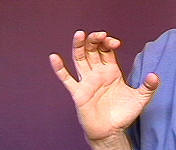
Discussion:
The number one-hundred-one is generally shown by doing: 1C01
Some people do 101 by showing the individual numbers one, zero, one (using a
small sliding movement.)
I do not recommend 1C1. I suggest you do NOT do 1X1 to mean
101.
DrVicars: How about the number 100? What is the handshape?
Student: The letter C.
DrVicars: Right! One bit of advice though--over time the signs mutate and
might not look like a C it might look like a crooked finger or the 1000
might look like a bent B
DrVicars: Why do we use the "C"
for a hundred, or an "M" for the number thousand? [Note: One of the ways to sign the number 1,000 is to make an "M" on the right hand, then touch the fingertips of the "M" to the center of the left "B" palm.]
Kloos: Same as Roman numerals
.
DrVicars: Right! Back in the "old days" it started out as an "M" but it has mutated to a bent
hand. Some people still do the letter M.
Kloos: How high should we be able to sign on the numbers?
DrVicars: infinity <grin> No really, just to the thousands, for
this class. To do the larger
numbers, you just string them together. For example, to sign 104 you can do
"1-C-4" or
"1-0-4." (I tend to do the 1-0-4 version) To do 111 you sign "1-C-11" and so forth up to
1000. Then you do 1-THOUSAND
(bent right "b" palm fingertips touch center of left flat
"b" palm).
American Sign Language University ™ ASL resources by Lifeprint.com © Dr. William Vicars